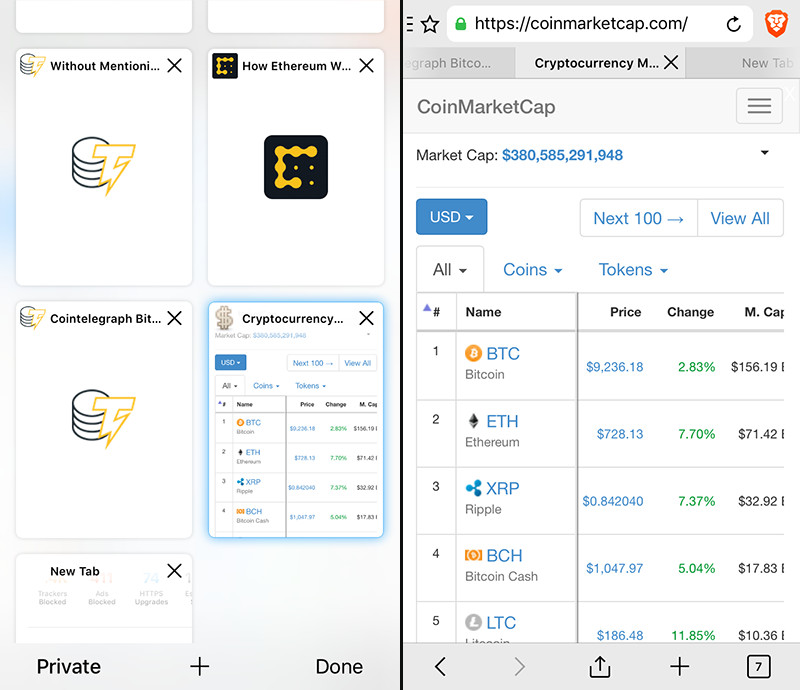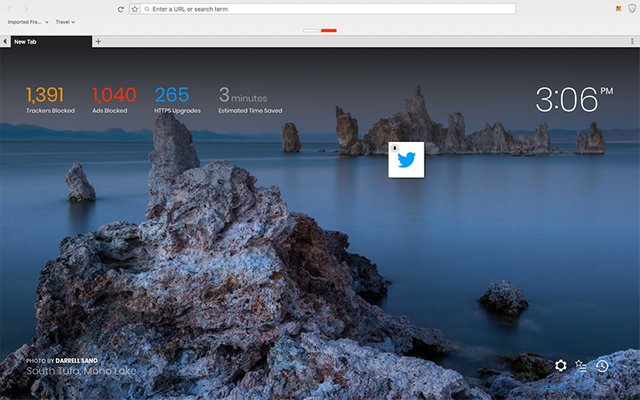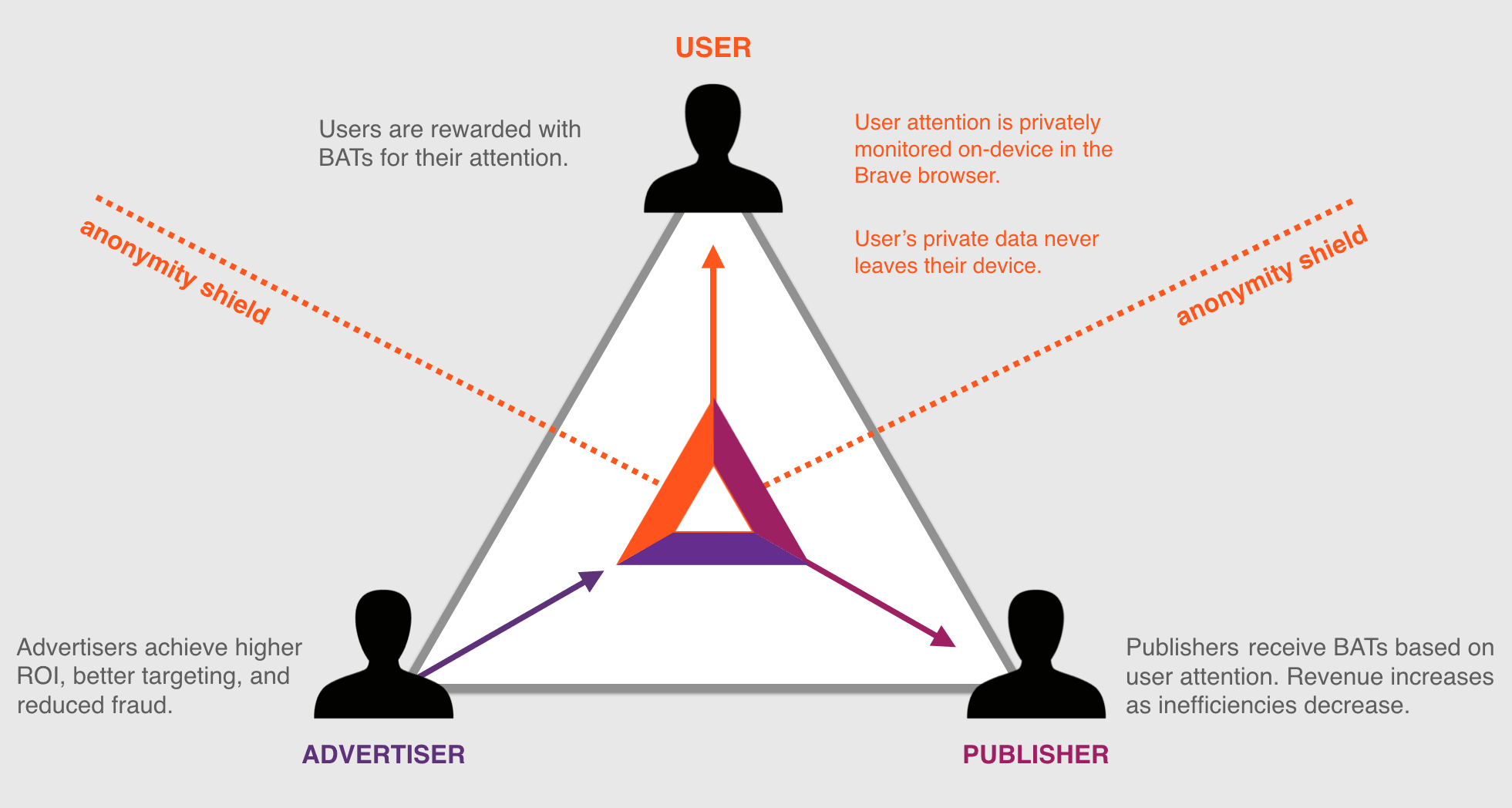Brave and Basic Attention Token: Aiming to Revolutionize Online Advertising
It’s no secret that online advertising is big business. At the end of the 3rd quarter, Google and Facebook reported ad revenues of $24 billion and $10 billion, respectively1, and in the US alone, the digital advertising market is expected to pull in a whopping $83 billion in 20182.
Most of that revenue will go to Facebook and Google because these companies collect massive amounts of data which allows them to deliver targeted ads towards specific consumers. But the digital advertising industry is ripe for disruption as consumers have become more aware of the scope of data being collected, and disgusted at how their data is being used.
The Brave browser and its integrated utility token, Basic Attention Token, are looking to shake up the online advertising industry by letting users control their own data, and by redirecting advertising money into the hands of both content publishers and ad viewers (yes, that’s you). And the developers plan to do it while making browsing the internet safer, faster, and more private.
Let’s first take a look at the Brave internet browser, and then see how it can be used to disrupt the digital advertising scene.
The Brave Browser is Faster, More Secure, and More Private
The Brave browser comes with all of the usual browser features, but what sets it apart are its two main value propositions. The first is improving user experience, and this is largely accomplished by blocking ads and trackers. This means faster load times, less data usage on your mobile plan (saving you not only time but money), less chance of being infected by malicious software, and enhanced privacy.
I started using Brave on my cellphone a few months back, and the browser has really impressed me. I can tell a noticeable difference in load times, and I’m a fan of the sleek interface:

More recently I switched to the Brave desktop browser and I can't see myself ever going back to Safari or Chrome. Load time is once again faster, and the number of ads I encounter has plummeted. The stats speak for themselves:

Brave has blocked over 10,000 tracker files and over 6,000 ads over the past month alone.
In addition to blocking ads and trackers, Brave also has https upgrades, meaning more of your connections are encrypted, protecting the data you send over the net.
You can get the Brave browser for free from Brave.com (referral) or from your mobile app store. Installation is a breeze and you can easily import your bookmarks and browsing data from your previously favorite internet browser.
How Brave and Basic Attention Token (BAT) Will Take on the Digital Advertising Industry
While the above features alone should entice customers to give the browser a try, Brave's second value proposition is more forward-thinking and ideological: users can play a direct part in helping to change how the digital advertising industry works. And they can get paid for doing it.
As it works now, companies pay handsomely to advertise on platforms like Google, Facebook, and Twitter. This works because the Googles and Facebooks of the world have been collecting massive amounts of data on their users - data that helps advertisers narrow down who might want to buy their products.
Occasionally content creators get a piece of the ad revenue, such as YouTube video creators, or website publishers who use Google Ad Services; but the companies in charge of the ad networks end up with the lion's share of ad revenue because they control the data.
The Brave team wants to change this system by giving individuals control over their own data; and, with the help of the Basic Attention Token (BAT) cryptocurrency, they aim to redirect the flow of advertising revenue away from data predators and instead distribute it throughout the internet community.
Take a second to check out the graphic below, and notice the user anonymity shield: the entire system revolves around the idea that user data stays on your device and is anonymously monitored via the Brave browser. Unlike Facebook and Google, Brave promises your private data will never be stored, sold, or otherwise recorded. The result is a delicate balance that can increase utility for everyone involved in the advertising industry.

A quick visual showing how Brave & BAT can benefit the entire digital advertising ecosystem: Image from basicattentiontoken.org
In addition to receiving all of the aforementioned benefits of the Brave browser, such as security, speed, and privacy, users can also choose to participate in an optional advertising system designed to incentivize ad-viewing.
The first incentive to watch ads is that users are paid for their attention with Basic Attention Tokens. These BAT can be traded in for bitcoin or cash, or they can even be used to pay or donate to digital content creators. Furthermore, Brave aims to make ad-watching more enjoyable as users will "receive fewer but better targeted ads".
Advertisers get targeted ads for less money, and Brave promises to provide increased transparency in how their ads are served. In addition, ads can be served at the browser level instead of the website level, meaning user data can be compiled based upon the entirety of a user’s browsing habits as opposed to the more limited data set that a single website may have access to - all while keeping your browsing data anonymous. Increased transparency in ad spend also allows for more efficient analysis of return on investment (ROI) for advertisers, leading to better decision-making and less waste.
Publishers of quality content can increase their revenue. When users receive BAT from advertisers, they have the option to use a portion (or all) of the BAT they receive to compensate their favorite publishers. This portion of BAT sent to publishers can be automatically distributed according to how much time (attention) the user gives to each site. The Brave/BAT team believes this will incentivize the creation of high-quality content as better content keeps users at a publisher’s site.
The entire system not only proposes how to revolutionize advertising, but internet content as a whole. Less ad revenue will go to scammy sites riddled with ads, eliminating the current financial incentive to create such sites in the first place. Instead, ad revenue will funnel toward content creators who truly provide value to content consumers, the way it should be.
Will it Work?
It certainly sounds like the BAT system could benefit everyone in the advertising space (except of course the current market behemoths like Google and Facebook), and Brave has made the software to participate in this new ecosystem open source so any internet browser or app can integrate – using Brave isn’t required to participate. The anonymity shield and BAT system could be used anywhere you see digital ads.
In addition, Brave and the Basic Attention Token project are headed by Brendan Eich, a long-time leader in the browsing space; Brendan was creator of the JavaScript programming language and co-founder of Mozilla.
Still, a number of factors have to come together for it to work, and they all center around adoption. First, people need to start browsing with Brave and publishers need to register with the BAT publisher platform. Only once a sizable market share is reached will enough advertisers join and truly begin to create a new paradigm.
Internet users must also be willing to allocate some of their earned BAT to pay their favorite publishers. Initial studies by Brave show people are willing, but we all need to understand how giving back to the sites, video creators, and other content publishers we love can incentivize high quality content and discourage low quality content at the same time. There must be a balance between earning BAT for viewing ads and redistributing a portion of our BAT to content creators.
Later in 2018 the advertisement program will roll out and users will begin to receive BAT rewards for viewing ads, but right now users can already download Brave and start to contribute to their favorite publishers (if the publishers have signed up with BAT).
Adoption starts with all of us. If we start using Brave, content publishers will come, and the advertisers will follow. So, why not give Brave a try? It’s probably faster, safer, and more private than any other browser you’re using. And in the near future you might just start getting paid to surf the web.
Users, get the free Brave desktop browser here (referral) or mobile browser at your app store.
Publishers, sign up for Brave payments at https://publishers.basicattentiontoken.org/
Sources: